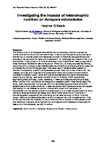Investigating the impacts of heterotrophic nutrition on Acropora microclados
| dc.contributor.author | O’Keefe, H. | |
| dc.date.accessioned | 2022-12-23T19:31:31Z | |
| dc.date.available | 2022-12-23T19:31:31Z | |
| dc.date.issued | 2022 | |
| dc.identifier.citation |
O’Keefe, H. (2022) 'Investigating the impacts of heterotrophic nutrition on Acropora microclados', The Plymouth Student Scientist, 15(2), pp. 298-319. | en_US |
| dc.identifier.issn | 1754-2383 | |
| dc.identifier.uri | http://hdl.handle.net/10026.1/20113 | |
| dc.description.abstract |
The Scleractinian coral Acropora microclados is a commercially important species that functions as both an autotroph and heterotroph. In ex situ coral aquaculture, elucidating an optimal diet to improve growth and resilience is critical in improving the sustainability and success of rearing corals for trade and conservation. To investigate the impacts of diet on A. microclados, three groups of 15 nubbins were kept under three different feeding regimes for three months at the National Marine Aquarium, Plymouth, UK. One group was fed nothing, the control (CTL), one group fed Artemia salina nauplii (ART) and one group fed a mixed diet of Artemia nauplii and microalgae (AA). They were kept in the same water system to maintain homogeneity of water quality between groups. Over the course of the study, their masses, volumes, and cross-sectional areas were measured to determine estimates of biomass and skeletal growth, along with qualitative observations of polyp coverage (e.g. bleaching, encrusting), used as an indicator of health. Nubbins in ART experienced significant growth from day 1 to 84, increasing in mass (p=0.033) and volume (p=0.035), while nubbins in CTL and AA did not display any increased growth. Over the course of the study, bleaching occurred in all groups, CTL and AA displaying equal levels while ART experienced a much lower proportion. These results align with previous studies that suggest that feeding on live Artemia nauplii can improve both growth and resilience in A. microclados, and that starved corals more easily succumb to stress-induced bleaching when relying on solely autotrophic pathways. ART had a higher proportion of nubbins with encrusting growth, suggesting that encrusting can be used as a sign of health in corals, though there are no previous studies to confirm or dispute this, only hobbyist opinion. This study demonstrates that Artemia can be an effective diet to improve A. microclados growth and resilience in aquaria, while highlighting the ample work still necessary to evaluate the feasibility of microalgae as live food for corals. | en_US |
| dc.language.iso | en | en_US |
| dc.publisher | University of Plymouth | en_US |
| dc.rights | Attribution 3.0 United States | * |
| dc.rights.uri | http://creativecommons.org/licenses/by/3.0/us/ | * |
| dc.subject | Coral | en_US |
| dc.subject | Nutrition | en_US |
| dc.subject | Acropora | en_US |
| dc.subject | Aquaculture | en_US |
| dc.subject | Growth | en_US |
| dc.subject | Heterotrophy | en_US |
| dc.title | Investigating the impacts of heterotrophic nutrition on Acropora microclados | en_US |
| dc.type | Article | en_US |
| plymouth.issue | 2 | |
| plymouth.volume | 15 |



